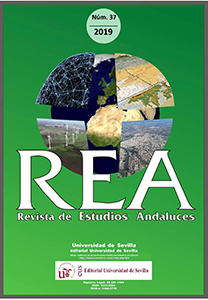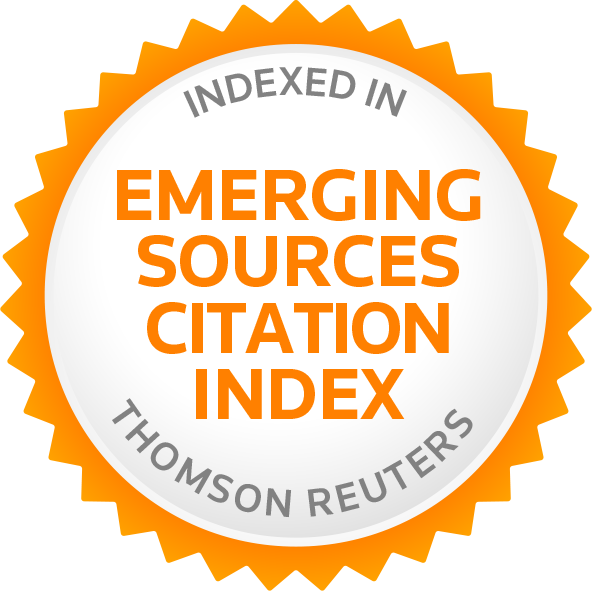Evaluación de las Áreas de Servicio de la Alta Velocidad Ferroviaria en la España Peninsular desde un Enfoque SIG Multi-método
DOI:
https://doi.org/10.12795/rea.2019.i37.09Palabras clave:
Estaciones ferroviarias de alta velocidad, área de captación flotante en tres pasos, accesibilidad territorial, equidad de servicio ferroviario de alta velocidad, ordenación territorialResumen
Las estaciones ferroviarias de alta velocidad son el único punto de acceso para poder disfrutar de este servicio ferroviario. Así, su ubicación y distribución espacial, y las carreteras para poder acceder a ellas adquiere gran importancia. Por este motivo, teniendo en cuenta la población de los municipios peninsulares españoles, se determina el grado de cobertura que ofrecen las 36 estaciones operativas existentes. Una metodología fundamentada en el método de determinación de áreas de captación flotantes en tres pasos, se desarrolla empleando medidas de accesibilidad territorial que fueron obtenidas mediante la herramienta de análisis de redes que ofrece un Sistema de Información Geográfica. Los resultados representados mediante cartografía temática permiten identificar los municipios con mayor cobertura ferroviaria de alta velocidad. También se identifican los municipios con menor cobertura, donde debería mejorarse el acceso por carretera de los residentes en estos municipios a las estaciones ferroviarias de alta velocidad.
Descargas
Citas
Auphan, E. (2002). Le TGV Méditerranée: un pas décisif dans l'évolution du modèle français à grande vitesse. Méditerranée, 98(1), 19-26.
Banister, D., y Berechman, Y. (2001). Transport investment and the promotion of economic growth. Journal of Transport Geography, 9(3), 209-218. doi: https://doi.org/10.1016/S0966-6923(01)00013-8
Bellet, C., Logroño, A., Pilar, M., y Casellas, A. (2010). Infraestructuras de transporte y territorio. Los efectos estructurantes de la llegada del tren de alta velocidad en España. Boletín de la Asociación de Geógrafos Españoles 52, 143-163.
Borzacchiello, M. T., Nijkamp, P., y Koomen, E. (2010). Accessibility and urban development: a grid-based comparative statistical analysis of Dutch cities. Environment and Planning B: Planning and Design, 37(1), 148-169. doi: https://doi.org/10.1068/b34126
Bosque, J. (1994). Geografía y geógrafos en la España contemporánea. Estudios Geográficos, 214(55), 13-45.
Bröcker, J., Capello, R., Lundqvist, L., Meyer, J., Rouwendal, J., Schneekloth, N., Van Vuuren, D. (2004). Final report of action 2.1. 1. of the European spatial planning observatory network (ESPON) 2000-2006. Christian-Albreschts-Universität Kiel: Kiel, Germany.
Comunidad Económica Europea. (1999). European Spatial Development Perspective (ESDP). Luxemburgo: Oficina para Publicaciones Oficiales de la Comunidad Económica Europea.
Comunidad Económica Europea. (2004). A new partnership for cohesion: convergence competitiveness cooperation. Luxemburgo: Oficina para Publicaciones Oficiales de la Comunidad Económica Europea.
Comunidad Económica Europea. (2006). Community Strategic Guidelines on Cohesion. Second report on economic and social cohesion 2006/702/EC. Luxemburgo: Oficina para Publicaciones Oficiales de la Comunidad Económica Europea.
Calvo, J. L., Jover, J. M., Pueyo, Á., Zúñiga, M., y Neffar, M. (2008). Les nouveaux bassins de vie de la société espagnole à l’aube du XXIe siècle. Revue géographique des Pyrénées et du Sud-Ouest. Sud-Ouest Européen, 26(1), 89-110.
Capel, H. (2007). Ferrocarril, territorio y ciudades. Biblio 3w, Revista Bibliográfica de Geografía y Ciencias Sociales, 12 (717).
Condeço, A., Gutiérrez, J., López, E., y Monzón, A. (2010). El valor añadido europeo de los proyectos transnacionales (TEN-T): una propuesta metodológica basada en los efectos de desbordamiento, accesibilidad y SIG. Paper presented at the Congreso Nacional de Tecnologías de la Información Geográfica (14. 2010. Sevilla) (2010) (pp. 420-438).
Condeço, A., Gutiérrez, J., y García, J. C. (2011). Spatial impacts of road pricing: Accessibility, regional spillovers and territorial cohesion. Transportation Research Part A: Policy and Practice, 45(3), 185-203. doi: https://doi.org/10.1016/j.tra.2010.12.003
Copano, L. (2018). Autonomía Local, Organización Territorial y Segregación Municipal. Revista de Estudios Andaluces 35, 63-100. doi: http://dx.doi.org/10.12795/rea.2018.i35.03
Delamater, P. L. (2013). Spatial accessibility in suboptimally configured health care systems: a modified two-step floating catchment area (M2SFCA) metric. Health & place, 24, 30-43. doi: https://doi.org/10.1016/ j.healthplace.2013.07.012
Domínguez, A., De Diaz y Pérez, J. M., y Lastra L.A. (2007). Las infraestructuras terrestres: instrumento para la integración de las áreas periféricas en el resto del territorio. En E. Rúa Alvárez (Ed.), Desarrollo y sostenibilidad en el marco de la ingeniería, (pp. 53-72). Sevilla: Colegio de Ingenieros de Caminos, Canales y Puertos.
Escolano, S. (2016). Territory and High-Speed Rail: A Conceptual Framework. En J. M. Ureña Francés (Ed.), Territorial Implications of High Speed Rail (pp. 53-74). Farnham: Routledge.
Frank, A. I., Mironowicz, I., Lourenço, J., Franchini, T., Ache, P., Finka, M., Scholl, B., y Grams, A. (2014). Educating planners in Europe: A review of 21st century study programmes. Progress in Planning, 91, 30-94. doi: https://doi.org/10.1016/j.progress.2013.05.001
Garmendia, M., y Ureña, J. M. (2007). Difusión del transporte de alta velocidad en el territorio: la alta velocidad ferroviaria. En A. Marín Moreno (Coor.), Competitividad, cohesión y desarrollo regional sostenible. Reunión de Estudios Regionales, (pp. 89-90). León: Asociación Española de Ciencia Regional.
Geurs, K. T., Krizek, K. J., y Reggiani, A. (2012). Accessibility analysis and transport planning: challenges for Europe and North America. Chenltenham: Edward Elgar Publishing.
Geurs, K. T., y Ritsema, J. (2003). Evaluation of accessibility impacts of land-use scenarios: the implications of job competition, land-use, and infrastructure developments for the Netherlands. Environment and Planning B: Planning and Design, 30, 69-87. doi: https://doi.org/10.1068 /b12940
Givoni, M. (2006). Development and impact of the modern high‐speed train: A review. Transport reviews, 26(5), 593-611. doi: https://doi.org/10.1080/01441640600589319
Gould, P. R. (1969). Spatial Diffusion. Resource Paper No. 4.
Gutiérrez, J. A., Naranjo, J. M., Jaraíz, F. J., y Ruiz, E. E. (2015). Estimación de la cohesión social en los municipios españoles tras la implantación de la Alta Velocidad ferroviaria. Boletín de la Asociación de Geógrafos Españoles (69), 113-138. doi: http://dx.doi.org /10.21138/bage.1892
Gutiérrez, J. (2001). Location, economic potential and daily accessibility: an analysis of the accessibility impact of the high-speed line Madrid–Barcelona–French border. Journal of Transport Geography, 9(4), 229-242. doi: https://doi.org/10.1016/S0966-6923(01)00017-5
Gutiérrez, J., y Urbano, P. (1996). Accessibility in the European Union: the impact of the trans-European road network. Journal of Transport Geography, 4(1), 15-25. doi: https://doi.org/10.1016/0966-6923(95)00042-9
Gutiérrez, J. (1998). Redes, espacio y tiempo. Anales de geografía de la Universidad Complutense, 18, 65-86.
Harvey, D. (1989). From managerialism to entrepreneurialism: the transformation in urban governance in late capitalism. Geografiska Annaler: Series B, Human Geography, 71(1), 3-17. doi: https://doi.org/10.1080/04353684.1989.11879583
Hey, C., Nijkamp, P., Rienstra, S. A., y Rothenberger, D. (1997). Assessing scenarios on European transport policies by means of multicriteria analysis. [En línea] < http://dare.ubvu.vu.nl/bitstream/handle/1871/ 9748/97086.pdf?sequence=1 >. [8 de diciembre de 2018]
Ingram, D. R. (1971). The concept of accessibility: a search for an operational form. Regional Studies, 5(2), 101-107. doi: https://doi.org/10.1080/09595237100185131
Instituto Nacional de Estadística de España (2017). Revisión del Padrón Municipal. Recuperado el 8 de diciembre de 2018, de https://www.ine.es/dynt3/inebase/index.htm?padre=525
Knowles, R. D. (2006). Transport shaping space: differential collapse in time–space. Journal of Transport Geography, 14(6), 407-425. doi: https://doi.org/10.1016/j.jtrangeo.2006.07.001
Levinson, D. M. (1998). Accessibility and the journey to work. Journal of Transport Geography, 6(1), 11-21. doi: https://doi.org/10.1016/S0966-6923(97)00036-7
Makri, M. C., y Folkesson, C. (1999). Accessibility measures for analyses of land use and travelling with geographical information systems. Department of Technology and Society, Lund Institute of Technology, Sweden, 1.
Martí, J. (2013). European integration and national models for railway networks (1840–2010). Journal of Transport Geography, 26, 126-138. doi: https://doi.org/10.1016/j.jtrangeo.2012.09.004
Martín, J. C., Gutiérrez, J., y Román, C. (2004). Data envelopment analysis (DEA) index to measure the accessibility impacts of new infrastructure investments: The case of the high-speed train corridor Madrid-Barcelona-French border. Regional Studies, 38(6), 697-712. doi: https://doi.org/10.1080/ 003434042000240987
Martínez, H. S., y Givoni, M. (2012). The accessibility impact of a new High-Speed Rail line in the UK–a preliminary analysis of winners and losers. Journal of Transport Geography, 25, 105-114. doi: https://doi.org/10.1016/j.jtrangeo.2011.09.004
McGrail, M. R., y Humphreys, J. S. (2014). Measuring spatial accessibility to primary health care services: Utilising dynamic catchment sizes. Applied Geography, 54, 182-188. doi: https://doi.org/10.1016/ j.apgeog.2014.08.005
Menéndez, J. M., Guirao, B., Coronado, J. M., Rivas, A., Rodríguez, F. J., Ribalaygua, C., y Ureña, J. M. (2002). New high-speed rail lines and small cities: locating the station. WIT Transactions on Ecology and the Environment, 54. doi: https://doi.org/10.2495/URS020771
Mérenne, B. (2008). La localisation des industries. Enjeux et dynamiques. Paris: Presses universitaires de Rennes.
Ministerio de Fomento de España. (2012). Plan de Infraestructuras, Transporte y Vivienda PITVI (2012-2024). Madrid: Secretaría de Estado de Infraestructuras, Transporte y Vivienda. [En línea] < https://www.fomento.gob.es/recursos_mfom/pdf/E35B8D33-F3B6-4695-9012-C22229966FA0 /130944/PITVI20122024.pdf>. [8 de diciembre de 2018]
Ministerio de Fomento de España. (Cartógrafo). (2013). Base Cartográfica Nacional, 1:200.000. [En línea] < http://centrodedescargas.cnig.es/CentroDescargas/index.jsp>. [8 de diciembre de 2018]
Ministerio de Fomento de España. (Cartógrafo). (2018a). Mapa Oficial de Carreteras Oficial.
Ministerio de Fomento de España. (2018b). Infraestructuras y Estaciones. Líneas de Alta Velocidad. [En línea] <http://www.adifaltavelocidad.es/es_ES/infraestructuras/lineas_de_alta_velocidad/lineas_de_alta_velocidad.shtml>. [8 de diciembre de 2018]
Miralles, C., y Cebollada, Á. (2009). Movilidad cotidiana y sostenibilidad, una interpretación desde la geografía humana. Boletín de la Asociación de Geógrafos Españoles (50), 193-216.
Morris, J. M., Dumble, P., y Wigan, M. R. (1979).Accessibility indicators for transport planning. Transportation Research Part A: General, 13(2), 91-109. doi: https://doi.org/10.1016/0191-2607(79)90012-8
Murayama, Y. (1994). The impact of railways on accessibility in the Japanese urban system. Journal of Transport Geography, 2(2), 87-100. doi: https://doi.org/10.1016/0966-6923(94)90015-9
Naranjo, J. M. (2016). Impacts on the social cohesion of mainland Spain’s future motorway and high-speed rail networks. Sustainability, 8(7), 624. doi: https://doi.org/10.3390/su8070624
Naranjo, J. M., Loures, L., Castanho, R., Cabezas, J., y Panagopoulos, T. (2018). Assessing the feasibility of GIS multimethod approach to ascertain territorial accessibility to hemodynamics rooms in Spain mainland. Habitat International, 71, 22-28. doi: https://doi.org/10.1016/j.habitatint.2017.11.001
Ortega, E., López, E., y Monzón, A. (2012). Territorial cohesion impacts of high-speed rail at different planning levels. Journal of Transport Geography, 24, 130-141. doi: https://doi.org/10.1016 /j.jtrangeo.2011.10.008
Pereira, M.A., Sagalés, O.R. (2003). Spillover Effects of Public Capital Formation: Evidence from the Spanish Regions. Journal of Urban Economics, 53 (2), 238-256. doi: https://doi.org/10.1016/S0094-1190(02)00517-X
Plassard, F. (1992). L’impact territorial des transports a grande vitesse. En P. H. Derycke (Coord), Espace et dynamiques territoriales (pp. 243-322). Paris: Economica.
Pueyo, A., Jover, J., y Zúñiga, M. (2012). Accessibility Evaluation of the Transportation Network in Spain during the First Decade of the Twenty-first Century. En J. M. Ureña Francés (Ed.), Territorial Implications of High Speed Rail. A Spanish perspective (pp. 83-104). Farnham: Ashgate.
Puga, D. (2002). European regional policies in light of recent location theories. Journal of economic geography, 2(4), 373-406. doi: https://doi.org/10.1093/jeg/2.4.373
Renfe. (2018). Trenes y trayectos. AVE. Recuperado el 8 de diciembre de 2018, de http://www.renfe.com/viajeros/larga_distancia /productos/index.html
Ribalaygua, C. (2005). Nuevas estaciones periféricas de alta velocidad ferroviaria: estrategias para su incorporación a las ciudades españolas. Colección Cuadernos de Ingeniería y Territorio, 5.
Salas, R., García, S. Á., y Rodríguez, J. P. (2002). Movilidad social y desigualdad económica. Papeles de trabajo del Instituto de Estudios Fiscales. Serie economía(7), 7-32.
Rockicki, B., y Stępniak, M. (2018). Major transport infrastructure investment and regional economic development-An accessibility-based approach. Journal of Transport Geography, 72. 36-49. doi: https://doi.org/10.1016/j.jtrangeo.2018.08.010
Schafer, A., y Victor, D. G. (2000). The future mobility of the world population. Transportation Research Part A: Policy and Practice, 34(3), 171-205. doi: https://doi.org/10.1016/S0965-8564(98)00071-8
Schürmann, C., Spiekermann, K., & Wegener, M. (1997). Accessibility indicators. Berichte aus dem Institut für Raumplanung, 39.
Sherman, L., Barber, B., y Kondo, W. (1974). Method for evaluating metropolitan accessibility. Transportation research record, 499, 70-82.
Tsamboulas, D. A., y Dimitropoulos, L. (1999). Appraisal of investments in European nodal centres for goods–freight villages: A comparative analysis. Transportation, 26(4), 381-398. doi: https://doi.org/ 10.1023/A:100513452
Ureña, J. M. (2012). Territorial Implications of High Speed Rail: A Spanish Perspective. Farnham: Ashgate.
Ureña, J. M., Menerault, P., y Garmendia, M. (2009). The high-speed rail challenge for big intermediate cities: A national, regional and local perspective. Cities, 26(5), 266-279. doi: https://doi.org/ 10.1016/j.cities. 2009.07.001
Vickerman, R. W. (1991). Transport infrastructure in the European Community: new developments, regional implications and evaluation. En R.W. Vickerman (Ed.), Infrastructure and regional development (pp. 36-50). Londres: Pion.
Wan, N., Zou, B., y Sternberg, T. (2012). A three-step floating catchment area method for analyzing spatial access to health services. International Journal of Geographical Information Science, 26(6), 1073-1089. doi: https://doi.org/10.1080/13658816.2011.624987
Willigers, J., y Van Wee, B. (2011). High-speed rail and office location choices. A stated choice experiment for the Netherlands. Journal of Transport Geography, 19(4), 745-754. doi: https://doi.org/10.1016/j.jtrangeo.2010.09.002
Descargas
Publicado
Cómo citar
Número
Sección
Licencia
La edición electrónica de la Revista de Estudios Andaluces se ofrece en acceso abierto desde el número 28 publicado en 2011 hasta la actualidad. Las ediciones impresa y electrónica de esta Revista son editadas por la Editorial de la Universidad de Sevilla, siendo necesario citar la procedencia en cualquier reproducción parcial o total.
La Revista de Estudios Andaluces no cobra tasas por el envío de trabajos, ni tampoco cuotas por la publicación de sus artículos. La Revista es gratuita desde el momento de la publicación de cada número y sus contenidos se distribuyen con la licencia “CreativeCommons Atribución-NoComercial-SinDerivar 4.0 Internacional” , que permite al usuario de la Revista de Estudios Andaluces criterios que cumplen con la definición de open access de la Declaración de Budapest en favor del acceso abierto. Puede consultar desde aquí la versión informativa y el texto legal de la licencia. Esta circunstancia ha de hacerse constar expresamente de esta forma cuando sea necesario.
Aceptado 2019-01-29
Publicado 2019-02-25







